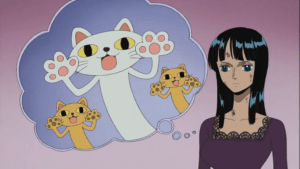
Race & Comics: Work the Angles (Sharp & Precise)
June 15th, 2010 by david brothers | Tags: Colored Commentary, DC comics, ian sattlerThe other day, I said this:
Who wants ##% of characters to fulfill some role? Straw men? Idiots? Let’s go with idiots.)
and reader Spacesquid said this in the comments:
Just to go partially off topic and stick up for statistics for a moment: demanding x% of characters fulfil some role is foolish, as you say, but pointing out x% of characters currently fulfil that role is different, isn’t it? in fact, how else can you have this conversation, unless it’s grounded either in a) the current proportions of various types of people, or b) how that proportion is changing as time goes on (either compared to the other proportions, or on its own terms)? What are examples but points of data, and what is the drawing of conclusions from those examples but the application of statistics?
I mean, sure, some people do it very, very badly, but at heart it’s still number crunching; at the end of the day (and acknowledging the unpleasantness of this being framed as white vs all others) I can’t see how “Here are six examples of non-white characters in DC being badly treated” is actually qualitatively different from “Here are the proportions of white and non-white characters in DC, and the proportion of those that have been badly treated”. The latter would take much longer to compile, but that makes it hard, not stupid.
In short, I think there’s a difference between stating statistics are irrelevant in these kinds of discussion and pointing out statistics can be applied in exceptionally stupid ways.
Or am I missing something?
It’s a good question and I wanted to take the time to give it the attention it deserves. There are situations where statistics and/or proportions may shed some light on a subject, and they often serve as a pretty decent starting point at best. What I am against, though, is the use of proportions or real-life census stats as a guideline or as a tool for discussing race in art. Now’s the part where I attempt to express why I think that’s a mistake.
Race, as we live it in the United States, is a way to group people based on shared lineage. Due to the way race was approached decades ago, it is very simplified and dumbed down. You could be Salvadoran and your friend could be Mexican, but on the census, you might be ticking the same box. If you’re Afro-Cuban, everybody you meet might assume you’re mainline American black. Our approach to race is a complex concept dumbed down, but still a huge part of our lives. I’m black and from Georgia. I’m black on both sides up to my great grandparents, but sometimes my facial hair comes in with a red tint. That makes me wonder what other races are floating around in my genes. But, for the purposes of America, that mixed ancestry doesn’t matter. I’m black.
The main source for race-related statistics is the US Census. It’s probably the only thing with a wide sample size and anything approaching accuracy. Roughly, and I’m rounding a bit here because the decimals are irrelevant, the Census says that the population of the United States breaks down to 75% white, 12% black, and 12% hispanic. The next highest represented race are Asians, then mixed race people, and then American Indians. (For some reason, all of these numbers, after subtracting 2.4% for mixed race people, add up to 110%. Don’t blame me, I’m an English major. Just ride with me and know that America keeps it 110% real. Or understand that the Census counts “Hispanic or Latino (of any race) and that messes up the numbers some. [This is why statistics are evil.])
 Applying a simplified version of these numbers to a comics universe means that you’d end up with 75 white people, 12 black people, 12 Hispanics of indeterminate origin, 3 asians, and 1 person to represent everything else. So then, when talking about racism or race in comics (they are two very different things), you could say that DC sidelining Wally West and his family reduces their Asian representation by an apocalyptic amount while reducing their white representation by a negligible number. That’s a fair point, and one way that statistics can be valuable.
Applying a simplified version of these numbers to a comics universe means that you’d end up with 75 white people, 12 black people, 12 Hispanics of indeterminate origin, 3 asians, and 1 person to represent everything else. So then, when talking about racism or race in comics (they are two very different things), you could say that DC sidelining Wally West and his family reduces their Asian representation by an apocalyptic amount while reducing their white representation by a negligible number. That’s a fair point, and one way that statistics can be valuable.
The problem comes in deciding which metric to use. If you use my hometown as a model, you’d have 62 white people, 32 black people, 1 asian person, 3 latinos, and 1 person to represent everyone else. You could pop Black Goliath, erase Jason Rusch, kill Bishop, and evaporate Ron Troupe and it would just be a really bad weekend, rather than a minor bit of genocide. If you killed Jaime Reyes and Hector Ayala, though, you just decimated the latino population.
It gets worse when you start looking at regions. Which side of town you lived on decided which high school you went to, and the racial make-up of the town gets even more complicated. When I went to school overseas, I was one of maybe eight black people in the whole school. I was related to one of the others, and only two of us were high schoolers. The rest of the population was majority white/Spanish, and then latino, and then Asian, and then other. If I stayed home sick, that high school suddenly became 50% less black than it was before. New York City is less than half white. San Francisco is 30% Asian. Atlanta is sixty-some percent black. Los Angeles is almost half latino. And on and on and on.
In real life, certain race-related statistics are so fluid as to be meaningless. I’ve lived in neighborhoods that were majority black, majority white, and evenly mixed. My group of friends over the years has ranged from exclusively black to mostly white to mixed evenly. Which one do you use as a guide? Where do you point and say “This is the right one?”
You can’t. All of them are right. Approaching race on a macro level, as in using the 75/12/12/3/1 ratio, is okay, but only for macro level things. It’s the barest of starting points, just something that gives you an idea that something is janky. The closer you dial in to a single person or area, the more the data twists and turns on itself. It’s like my English major’s understanding of the Heisenberg uncertainty principle. The more accurate you try to be, the less you reflect the reality of the situation.
 “America is 12% black” is an accurate statement. It is true for a very specific situation. What it isn’t, however, is real. You can’t actually use it to reflect real life, because real life generally doesn’t support that number. It’s being measured on too large of a scale. It’s like–the universe is more empty than it is full. There are electrons and atoms and whatever, but the space between them is what creates that figure. From our point of view, though, the universe is full of stuff. Its emptiness is something too big for us to see, like the exact racial proportions of the United States are something that only matters on a very high level and doesn’t really reflect life down here on the street.
“America is 12% black” is an accurate statement. It is true for a very specific situation. What it isn’t, however, is real. You can’t actually use it to reflect real life, because real life generally doesn’t support that number. It’s being measured on too large of a scale. It’s like–the universe is more empty than it is full. There are electrons and atoms and whatever, but the space between them is what creates that figure. From our point of view, though, the universe is full of stuff. Its emptiness is something too big for us to see, like the exact racial proportions of the United States are something that only matters on a very high level and doesn’t really reflect life down here on the street.
Applying this to comics seems to me like an error in approach, and paying attention to diversity for diversity’s sake, rather than just writing books like real life looks. One of the most interesting comics on the stands has a 100% Japanese cast. One Piece
exists in this bizarro world where the main cast is from Brazil, Japan, Sweden, Africa, France, Canada, Russia, USA, and Austria. Unknown Soldier
is majority black. Wildcats 3.0 and Flex Mentallo were majority white. Were there any black people in Calvin & Hobbes?
Here’s the root of my problem with running with percentages: good stories are good independent of color. I think that, as children, it is important to see people who look like you doing positive and negative things. That’s one of the reasons I’m so thankful Milestone existed. But, overall? If you’re grown? If it’s good, it’s good.
Good writers and artists pay attention to things and create stories that stand head and shoulders above the pap. There was this recolored Legion of Superheroes thing that made the rounds last year. I thought it was pretty dumb, because all the choices seemed pretty arbitrary. Same thing with “Chromatic Casting.” There was no reason behind it beyond making the Legion less white. As far as reasons go… it works, up to a point. This, though, went far beyond that point into… what? Showing how things could be? That’s not how this works. What good is that? Let’s deal with the real, and if it’s artificial? Let it be.

There should be a reason for everything. If you decide to make a white character, you should know why you made him white and how that affects his characterization. If you make a black heroine, you should know why she’s black. Arbitrary decisions, or decisions made according to numbers, serve no one. People who think about their choices and create accordingly, those are the people who make a difference. Those are the people who make stories that matter.
An example of how to use statistics: Most black people marry other black people. Last I read, something like 93% overall marry within their race. If you look at comics… you can count the number of regular or high profile black/black relationships on what, one hand? It took until 2006 for Storm, the highest profile black hero by far, to start dating a black dude. So, if you look at the real life numbers (high percentage of blacks marry blacks) and compare them to comics (interracial marriage is more common than black/black relationships), you have the ingredients for an argument. What you don’t have is an argument, not yet. You need to look at the situation, examine the history, look at the characters involved, etc etc. You need to see about some context before you can say anything, and just saying “It’s 93% here and 10% there” isn’t enough.
One million words later: that’s why I don’t like using numbers to talk about race online. It works until it doesn’t, and when it stops working, it really stops working. It works as a starting point, just something to give an idea form, and then you need to find something else.
The only statistic that you need to know is that 4thletter! keeps it 2010% real.


The census actually has some of the weirdest definitions of race due to various court rulings, so you have strange things like Hispanic (which is a problematic term already) being a separate question and people that identify as Arab having to mark down as “white”
I liked your Heisenberg implications. I’ve found that you seem to write some of the more insightful pieces about race in comics. Please keep it up.
@jayfarer: Yeah, I’d always heard the census figures growing up, but I had no idea that they weren’t as simple as “Add all these up to get 100%.” I think that this year’s Census was supposed to fix it by saying “Hispanic is not a race,” but that’s not a fix so much as a “This is broken and we know it but we don’t know what to do.”
I spent longer than I should have trying to figure out how that One Piece gif tied into the rest of the article. Is this use of somewhat-unrelated images a new style for you David? Because I like it.
(or maybe I’m being an idiot and not noticing how they are related. feel free to scold my picto-illiteracy)
That Drake gif is hypnotic.
[…] David Brothers discusses race, statistics, and mainstream superhero comics in a post that features hypnotic Kanye West and Drake gifs. […]
Just wanted to echo the sentiment that there is some intelligent analysis going on here and I really appreciate these thoughtful posts on race. It reminds me of when you were talking about Obama’s race a while back, and we got into the differences between race and ethnicity, which are not necessarily interchangeable concepts.
Anyway, I think you made a couple of sterling take aways here, 1) that good comics are good regardless of color, and 2) if you’re going to deliberately include a character of a specific race, know why you’re doing it, otherwise it’s just kind of blind tokenism.
It took until 2006 for Storm, the highest profile black hero by far, to start dating a black dude
She dated Bishop, like, a billion years before that.
It’s the X-Men, so that statement is probably even literal. I don’t remember, their first hookup could have been like hey let’s go for coffee in Pangea, we could accidentally fuck up causality and create a universe where mutantkind never existed, then spend twelve issues unshitting our time-bed. You know nothing commital, keep it casual and see where things go.
@Dan: When did she date Bishop? When he first appeared, he was too busy being starstruck to try to date her. In X-Treme X-Men, he was busy being Mutant Cop. I think the farthest Storm/Bishop went was fan speculation.
@Jordan: Nah, none of them are related.
@david brothers: IIRC, when Bishop was introduced in Uncanny X-Men, there seemed to be heavy hints they would end up together. Especially since Forge suddenly gave Storm an ultimatum two issues after Bishop appeared, in #289: elope with me or stay with the X-Men.
In the next issue Forge leaves her anyway, saying she’s to committed to the X-Men, before she can answer. On the final page, there’s two panels, one with a suddenly alone Storm going “I… was going to say…” the second with “Yes.” with Bishop watching the whole thing from a balcony. The gratuitous placement of him in the shot seemed to scream- and this is Scott Lobdell, who’s never been subtle- that they were to become an item. Especially since Forge’s departure felt forced and made him look like an asshole. To me, anyway.
But the funny thing is, they never did get together, AFAIK. Bishop wound up dealing with his own insufferably tangled continuity (again and again and AGAIN) too often to stop for loe.
@ Dan Coyle: It’s been recently established that Storm is Bishop’s grandmother… possibly. hints at this. Commence shuddering.
@ David:
Is this the leaked script for Marvel vs. DC 2: Ultimatum?
OT: This post needs to be part of a writer’s bible. Great work.
“You could pop Black Goliath, erase Jason Rusch, kill Bishop, and evaporate Ron Troupe and it would just be a really bad weekend, rather than a minor bit of genocide. If you killed Jaime Reyes and Hector Ayala, though, you just decimated the latino population.”
That was the section I was trying to quote. Hopefully my punchline makes a little more sense, now that there’s an actually joke attached.
Hobbes.
@Tom Spurgeon: I will gladly claim Hobbes on behalf of my race!
@david brothers: You know, initially I always imagined Hobbes being voiced by Clevon Little.
So, first you get obama because he’s half-black and now Hobbes? He’s AT LEAST 70% Orange.
@steve: Hey man, I called dibs. That’s like calling shotgun–no take backs!
Re. black/black vs. interracial relationships:
Is my impression correct that you were using the number of single-race and interracial marriages (however people who marry more than once in their lives are counted) in real life as reference for relationships that include marriage, but also people who are just dating in comics (i.e. not exactly the same thing)? Also, let’s not forget that not all of Marvel’s characters are US citizens and/or residents. BTW, Storm took about a decade to start dating anybody (Forge, whom she first met in UXM #186). (She first met the Black Panther in flashback in Marvel Team-Up #100, but although the two felt somewhat attracted to each other, they did not go on a date.)
For Marvel’s first black characters, black/black marriages and relationships seemed to be the norm, IIRC (Joe and Martha Robertson (married), Black Panther and Monica Lynne (eventually engaged), Black Goliath and Dr. Claire Temple (divorced), the Prowler and Mindy McPherson (eventually married), and IIRC the Falcon was involved with Leila Taylor).
@Menshevik: I’m not sure what the residency status of Marvel’s characters has to do with anything. In fact, the one I specifically mentioned is a US citizen by birth. And yes, I was using marriage numbers and comparing them to dating and marriage in the Marvel Universe. No, it isn’t the same thing, but that is a real life trend that isn’t reflected in comics. I’m not sure why that’s a problem. No, it isn’t 1:1, but if most black people marry other black people, it naturally follows that most black people have, at some point, dated other black people. What’re you saying?
For your latter point–Joe and Martha probably hold the crown for first and longest relationship, but Monica Lynne, Claire Temple, Leila Taylor don’t exactly invalidate my point. Deathlok theoretically has a black wife kicking around somewhere, too. But, if you go down the line, I think that you’re much more likely to find black characters in interracial relationships than you are in black/black ones.
I believe Hispanic persons are counted twice in the Census figures here (because Hispanic is not truly a racial category); if you don’t subtract the 2.4% who identify as mixed-race, but do subtract the 12% who identify as Hispanic, the numbers should roughly equal 100%.
[…] it’s not like other people aren’t still doing inspirational work. David Brothers, in particular, has done some excellent online writing about race in comics. Chris Sims’ […]